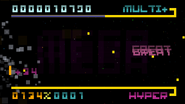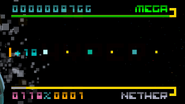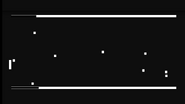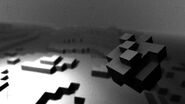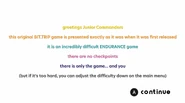BIT.TRIP BEAT is the first game in the BIT.TRIP Hexalogy. It, like its sequels and spin-offs, is a rhythm game, styled after the 1972 game, Pong. It was originally released on Nintendo's WiiWare service in 2009, before later releasing on mobile phones and PC. While being a fun game in its own right, it was also greatly influential, proving that independently developed video games had a place and a right to exist alongside the Triple A gaming industry. BEAT would be followed by five sequels for a complete Hexalogy, as well as two spin-off titles and its main character, CommanderVideo would accrue a litany of cameo appearances in other games, culminating in a Trophy in Super Smash Bros. for Wii U, a great honor for any Indie character.
The game's plot was introduced as being 'A clueless plotline depicting nothing but retro nonsense'. However, as more and more games released, this story began to evolve into something far more profound, yet still just as abstract as the original.
The title theme, Move to Intercept, and the credits theme, The Information Chase, are provided by guest composter Bit Shifter
GAMEPLAY[]
In the game, which is a lot like that of Pong, the player takes control of the Paddle, an orange rectangle that can only move up and down.
The Paddle's elevation is controlled via a variety of means. In the original WiiWare version, it's controlled by holding the Wii Remote sideways and tilting it left and right. On the PC releases, it can be controlled with the mouse, though the player can plug in a controller and use the left stick to control the Paddle if they so choose. The PlayStation versions are controlled the same way, making use of the analog stick for moving the Paddle. And lastly, the mobile, tablet and 3DS versions make use of the devices' touchscreens which can allow for ultra-precise movement.
Moving the Paddle and pausing the game are the only actions the player can take. As such, the game seems deceptively simple.
In actual gameplay, the player must move the Paddle, positioned on the far-left side of the screen, and hit incoming squares known as Beats. When a Beat strikes the Paddle, it will make a sound and typically rebound back in the direction it came from where, upon hitting the far-right side of the screen, it will vanish and make complimentary sound. If the player misses a Beat, it will vanish and let out a disruptive percussion noise instead. The ultimate goal is to hit as many of these Beats as possible without missing any. In doing so, the music will gradually improve, with the noises the Beats make playing complimentary to the background music. Missing too many Beats, however, will eventually result in failure, and the player will have to restart the entire level from the beginning, as there are no checkpoints.
There are a variety of different types of Beats that the player will encounter, each one with different properties denoted by their colour. Learning their behaviors can aid in the player's ability to deal with them effectively.
- Yellow Beats will merely bounce back the same way they came after one hit. A majority of Beats have the same rebound behavior as the Yellow Beats.
- Orange Beats will bounce away in a parabolic arc after hitting the paddle. Once they reach the apex of the arc, they will fall back and need to be hit again. They can require up to six rebounds before they finally stop bouncing. Orange Beats and Blue Beats are the only types of Beats that need to be hit multiple times.
- Pale Yellow Beats behave the same way as regular Yellow Beats. However, when they hit the Paddle, they will freeze in place for a few moments before rebounding. This is purely a cosmetic feature intended to throw off players who don't expect them.
- Neon Green Beats behave identically to Yellow Beats, however they rhythmically blink, making them more difficult to see. They are used the must during scenes which can be visually overwhelming, in order to get the most out of them.
- Pale Blue Beats do not have their own movement patterns, and instead, move depending on where the Paddle is. In some instances they follow the Paddle, while in others, their movement is inverted. Their movement usually has a delay to it, though it's less significant when they appear in pairs.
- Navy Green Beats will freeze in place and move in jagged patterns, often requiring preemptive timing as they appear and wait while other Beats are being dealt with.
- Teal Beats will bounce along the MODE-Up and MODE-Down bars on the top and bottom of the play area. Their movement is intended to make the player panic, when in actuality their patterns are usually very simple.
- Pink Beats appear moving in circular patterns, sometimes in pairs which require strict positioning of the paddle to hit.
- Indigo Beats appear in sine wave formation. This movement, like most, is merely used as a distraction, as most of the time, the appear in groups and will all strike the same location.
- Dark Blue Beats are larger than other Beats. When hit, they will fly back a short distance before exploding into several more Beats that will need to be hit again.
- Red Beats will freeze the Paddle in place momentarily. They count as regular Beats and must be hit in order to obtain a Perfect score.
- Cyan Beats serve to break each stage into segments, providing a moment recuperation. They pulsate, but are otherwise identical to Yellow Beats.
- Rainbow Beats are larger Beats that flash multiple colours. They appear in small groups and serve to cap off the end of a Stage. There are seven groups Rainbow Beats per Level, with the eighth stage being capped by a boss, and thus, no eighth group of Beats. Rainbow Beats do not rebound, and instead simply vanish upon hitting the Paddle.
Additionally, there are White Beats that give one of three power-ups that alter the Paddle in some way. Avoiding these can be done, but doing so will practically guarantee a lost Perfect run. The first two will either elongate or duplicate the paddle, giving you more room to work with, while the last one will activate Challenge Mode, which shrinks the Paddle and gives you a bonus afterwards. Should you avoid the first two, the following set of Beats will be impossible to hit without missing some. Avoiding the Challenge power-up will make the upcoming section easier, but you'll miss out on the bonus, which is required for a Perfect run.
Beats can also appear with trails and links. Trails serve no function other than looking pretty. Meanwhile, Links will cause all connected Beats to rebound after just one of them is hit. Links usually don't appear until just before the set of linked Beats reaches the Paddle, making them frustrating to predict. If one Linked Beat is missed, its link is severed, but the remaining Beats can stay linked and still be hit as a single unit.
MODES[]
The game features a reward-system in the form of its MODE system. Each MODE alters the visuals and music considerably, making the game more forgiving, the better the player performs. If you want to reach the end of each level, trying to maintain the highest MODE is in your best interests.
MEGA[]
The highest mode of this game. The music gets an extra percussion, and special visual effects are added to the gameplay. Achieving a MODE-Up while in MEGA will grant a MULTI+ score multiplier. Achieving a MODE-Down will bring the player down to HYPER, regardless of whether they've achieved a MULTI+.
HYPER[]
This is the MODE that the game starts in. In this mode the colours and visuals are very basic and plain, and the music is simple. In order to MODE-Up, the player must hit 80 Beats (40 on Easy and 120 on Hard). Getting a MODE-Up will bring the player to MEGA. While a MODE-Down will bring them to NETHER.
NETHER[]
Mode down to here, and you lose all sense of music and colour. The HUD is black-and-white, there is no information to show, and each reflect makes a dull beeping sound. There is no point payout while in NETHER, meaning the only purpose for Beats is to climb back up to HYPER.
LEVELS[]
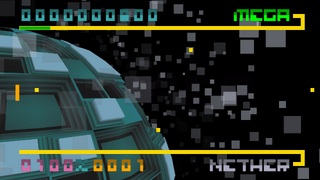
TRANSITION[]
The first level. Life begins with the game's opening cutscene, a figure races by the screen, then Commander Video appears. Beats swarm into him and he awakens with new life. TRANSITION is an easy level with slight difficulty spikes and has some nice sugar-sweet tunes.
DESCENT[]
It begins with Commander Video stepping forward and tripping over. DESCENT has serious and percussion based music with one of the the fastest tempos in the whole series. The background shows a planet and soon begins it's DESCENT. The level features magma filled backgrounds, and a breakout game at the planet's CORE. Houses the one of the hardest CHALLENGE sections in the series. There are two challenges in this level.
GROWTH[]
Known as one of the hardest levels in the series, GROWTH begins as Commander Video is shown being brained by a mean green beat. The level begins fairly difficult with a background of green fibers. The tempo is slow and the level is heavily percussion based. The level features tons of gimmicky obstacles, making the level challenging. The ability to focus beyond your paddle is vital to completing the level. At the end of the level a game of Pong rages in the audience of a bright-red Core.
Version-Exclusive Content[]
Wii, 3DS, and Switch[]
The compilation re-releases, BIT.TRIP COMPLETE, BIT.TRIP SAGA, and the Port for the Wii, 3DS and Nintendo Switch respectively contained a handful of exclusive features. In COMPLETE and the Switch Port, BEAT was given a new challenge mode, featuring several pocket-sized levels all centering around a theme. In both COMPLETE and SAGA, the game was given a unique intro where the logo appears on a black screen and music plays after the subtitle appears. This intro was based on the very intro featured in all releases of BIT.TRIP RUNNER. The Switch and Steam versions display a background and the game's controls in the form of a loading screen instead of the intro the Wii and 3DS versions had..
Steam[]
The Steam release of the game featured a collection of superficial content, including Achievements, alongside Trading Cards and Badges.
Leading up to the release of Valve Software's Portal 2, the Steam version of BIT.TRIP BEAT received an update, adding a fourth level entitled <TEST>. Completing the stage originally rewarded players with two opportunities to obtain potatoes for the promotional event. <TEST> is still available in the Steam versions, provided they are purchased after already having Portal 2 in one's library, but it no longer unlocks anything.
Additionally, a third potato could be earned by hitting the wall behind the boss of DESCENT in MEGA, while the event was live.
The purposes of the event was to reward certain players with the ability to play Portal 2 early.
SCOREBOARD[]
See the BIT.TRIP BEAT Scoreboard
